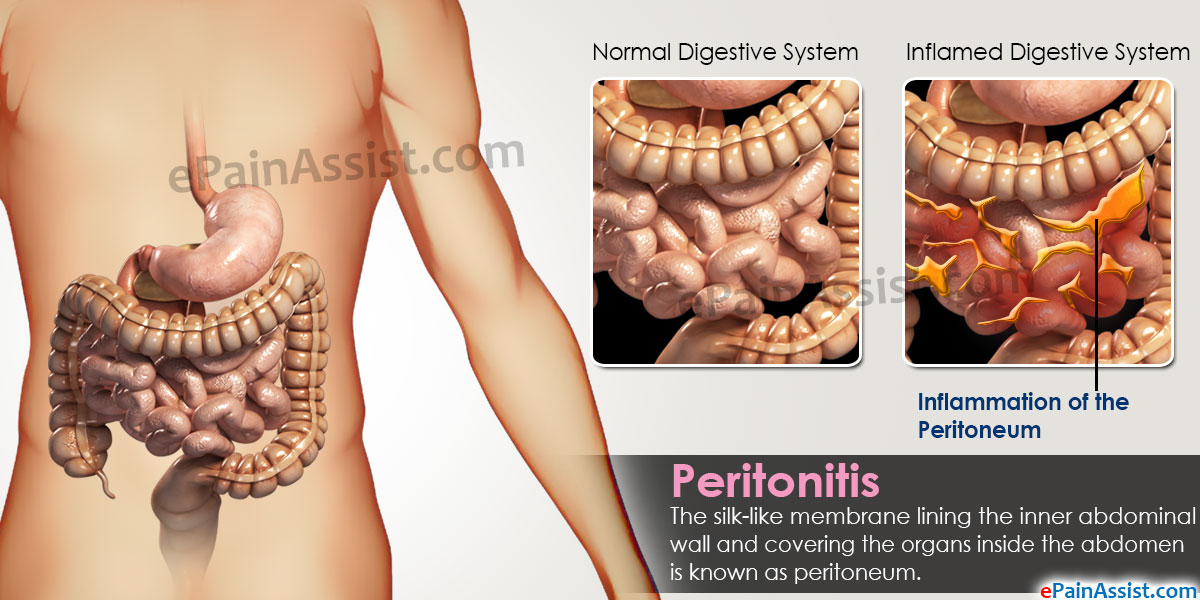What Is Peritonitis?
The silk-like membrane lining the inner abdominal wall and covering the organs inside the abdomen is known as peritoneum. Peritonitis is a condition where there is inflammation of the peritoneum. Peritonitis commonly occurs from bacterial or fungal infection. It can also occur as a complication of other medical problems. Peritonitis can also result from any rupture or perforation in the abdomen. Immediate medical attention is required to treat peritonitis to fight the infection. Also, if it is occurring due to any underlying medical conditions then that needs to be treated. If peritonitis is not treated, then it can lead to life-threatening or fatal infection in the entire body.
Antibiotics are the main line of treatment for peritonitis. Surgery may be needed in few cases.
Causes of Peritonitis
There are many causes for peritonitis. Perforation or rupture within the abdominal wall is the common cause. If this condition develops without an abdominal rupture, then it is known as spontaneous peritonitis; though this occurs rarely.
Some of the common causes of abdominal ruptures, which cause peritonitis are:
- Medical conditions, such as stomach ulcer, ruptured appendix or a perforated colon can also lead to peritonitis, as these conditions give easy access to bacteria to enter the peritoneum through a hole in the gastrointestinal tract.
- Peritoneal dialysis where catheters are used to remove any waste products from the blood due the inability of the kidneys to do so. If the surroundings are not clean, proper hygiene is not maintained or if there is any contamination of the equipment, then it causes this infection. Gastrointestinal surgery can also lead to peritonitis as its complication. It can also rarely occur as a complication to endoscopy or colonoscopy.
- Pancreatitis is the inflammation of the pancreas, which if spreads outside the pancreas, can lead to peritonitis.
- Diverticulitis is the infection of the small, bulging pouches present in the digestive tract. If these pouches rupture, then it can cause peritonitis by releasing waste products from the intestine into the abdominal cavity.
- Trauma or injury can also cause peritonitis by giving access to bacteria or chemicals from other regions of the body to the peritoneum.
- Spontaneous peritonitis develops without any abdominal perforation. This commonly occurs as a complication of liver disease like cirrhosis. In advanced cases of cirrhosis, there is accumulation of large amount of fluid in the abdominal cavity. This condition is known as ascites and this accumulated fluid is susceptible to bacterial infection.
Risk Factors for Peritonitis
- Patients who are undergoing peritoneal dialysis are at an increased risk for Peritonitis.
- Having a previous history of peritonitis makes a person more vulnerable to developing peritonitis.
- Other medical conditions, which increase the risk of peritonitis, are: Appendicitis, cirrhosis, stomach ulcers, Crohn’s disease, pancreatitis and diverticulitis.
Signs & Symptoms of Peritonitis
- Pain and tenderness in the abdomen.
- Abdominal distention or bloating, which is a feeling of fullness in the abdomen.
- Fever.
- Loss of appetite.
- Nausea and vomiting.
- Diarrhea.
- Decreased urine output.
- Increased thirst.
- Not being able to pass stool or gas.
- Fatigue.
Symptoms of peritonitis in a patient receiving peritoneal dialysis include:
- Cloudy appearance of the dialysis fluid.
- Presence of strands or clumps (known as fibrin) or white flecks in the dialysis fluid.
Peritonitis can easily turn life-threatening if it is not immediately treated. If you are experiencing any of the above symptoms, then please contact your doctor immediately.
Investigations for Peritonitis
- Medical history and physical exam.
- Signs, such as cloudy dialysis fluid in peritonitis associated with peritoneal dialysis, are sufficient diagnosis.
- Secondary peritonitis which occurs as a result of other medical conditions or spontaneous peritonitis requires the following tests for confirmation of diagnosis:
- Blood tests & culture.
- Imaging tests such as x-ray, ultrasound and CT scan to check for perforations.
- Paracentesis is the analysis of the peritoneal fluid. This is done using a thin needle through which a sample of the fluid is taken from the peritoneum. This sample is sent to the lab to check for an increased white blood cell count, which indicates inflammation or infection. Culture of this fluid can also be done to find out if any bacteria are present.
Treatment for Peritonitis
Treatment for peritonitis consists of hospitalization to treat the infection occurring from other medical conditions. Treatment comprises of:
- Antibiotics are the main line of treatment to help in fighting and preventing the infection from spreading. The severity and the type of peritonitis decide the antibiotic given and the length of time for which it is given.
- Surgery for peritonitis is needed for removing the infected tissue, treating the underlying cause of peritonitis and preventing the infection from spreading. Surgery for peritonitis is done in cases, such as ruptured appendix, colon or stomach.
- IV (intravenous) fluids are given.
- Pain medications are given to relieve pain caused due to Peritonitis.
- Supplemental oxygen is given to alleviate breathing problems.
- Blood transfusion may be required in some cases.
Prevention of Peritonitis
The following steps can be taken to prevent peritonitis which occurs in patients receiving peritoneal dialysis. In these conditions, peritonitis often occurs due to germs present around the catheter and for this the following steps should be taken:
- Before touching the catheter, remember to always wash your hands, especially under the fingernails and spaces between the fingers,
- Keep the supplies in a clean and sanitary area.
- Use an antiseptic to clean the skin surrounding the catheter every day.
- If pets are present in the house, do not let them near you or sleep with them.
- Always wear a surgical mask when going for dialysis fluid exchanges.
- Consult your dialysis care team regarding proper care for the catheter used in peritoneal dialysis.

